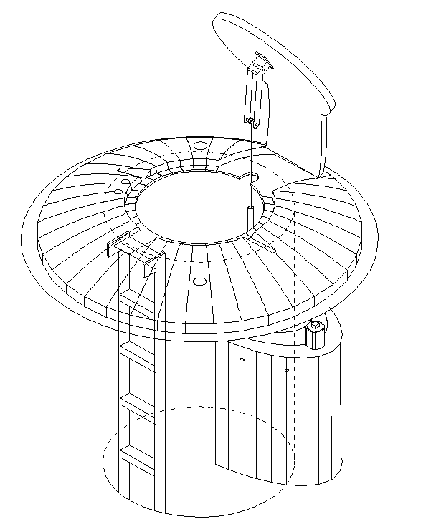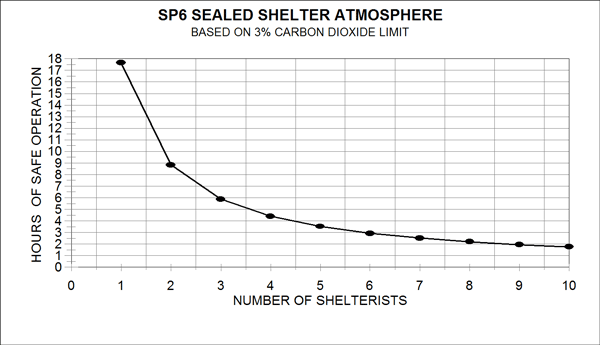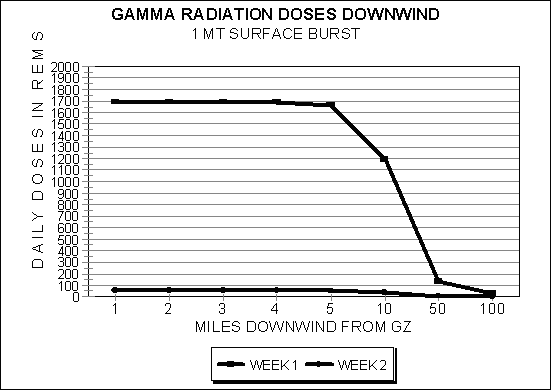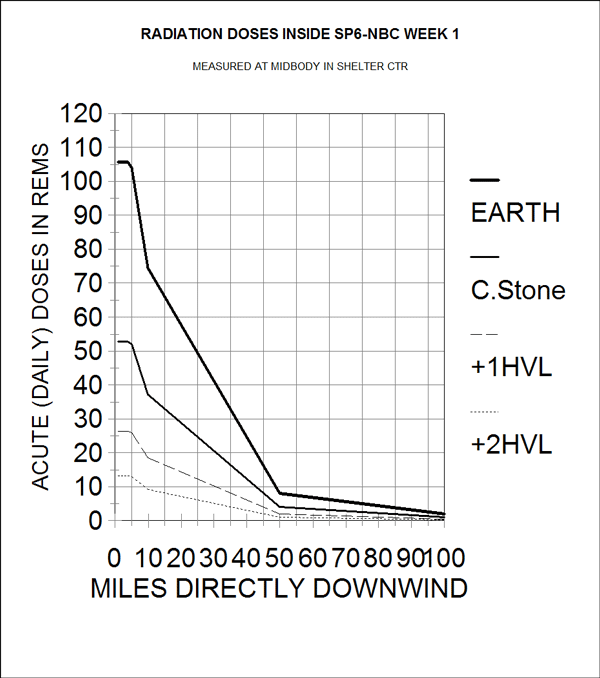|
SP6 Storm Shelter
The SP6 is a totally self-contained 15 psi ribbed paraboloid (egg shape) underground disaster shelter designed to protect 6 adults for 2.5 to 14 days or 10 people for short durations such as during tornadoes. The product was specifically designed and developed to protect people during and after disasters such as tornadoes, hurricanes, earthquakes, storms, forest fires, power failures, radioactive iodine gas from a nuclear power plant accident, and biological-chemical terrorism warfare. The SP6 is classified as tornado or storm shelter and the SP6-NBC is classified as an NBC (nuclear-biological-chemical warfare) shelter. A tremendous effort has been made to think of every conceivable incident that shelterists could face in the SP6 shelter. Many geometrical shapes were experimented with before finalizing the SP6. The SP6 comes in two models. The SP6 includes the structural fiberglass paraboloid, cedar floor, water tank, chemical toilet, air blower, battery box with one battery, light, battery charger, hatch, and tie downs for high water tables. The SP6-NBC is additionally equipped with a HEPA filter, carbon filter, gas agent test housing, survey meter, chemical agent detection kit, six 12- volt deep cycle batteries, counter and sink, water filter with foot pump, air inlet and outlet valves with screens, etc. The SP6 can be upgraded after installation to a SP6-NBC. The SP6 is shipped completely assembled.
Design The SP6 is a third generation disaster shelter designed and developed by Walton W. McCarthy, M.E., author of PRINCIPLES of PROTECTION, U.S. Handbook of NBC Weapon Fundamentals and Shelter Engineering Standards, Fifth Edition 2002 which is the United State’s bible on shelter engineering. He is the principle engineer of Radius Engineering Inc., with over 24 years experience designing “high- tech” disaster shelters. The book is distributed by The American Civil Defense Association (TACDA) in Starke, Florida, and is known in the industry as P.O.P. The SP6 was designed using CAD (computer aided drafting), CAE (computer aided engineering), and FEAM (3-dimensional finite element analysis and modeling). The paraboloid shape of the SP6 allows it to be a true pressure vessel for resistance to high external pressure and full height water tables. The SP6 shelter system is based on 12 years field experience with McCarthy’s successful TBC6, ES10 and larger sisters, P6 and P10 fiberglass underground shelters. The hatch at ground level of the SP6 is available in several different levels of threat resistance. Shelter Construction The paraboloid shelter and entranceway are made of structural fiberglass manufactured to underground storage tank standards of Underwriters Laboratory, American Society of Testing and Materials, and shelter engineering standards of PRINCIPLES of PROTECTION. Fiberglass was chosen as the optimum material because of its extremely high resiliency and corrosion resistance plus its ability to be shaped into a compoundly curved structure. The 15 psi (pounds per square inch) external pressure resistance, with no earth arching, is constant over 100 years and does not have to be de-rated each year like steel due to corrosion. Fiberglass also forms a complete vapor barrier which provides a dry atmosphere when placed below ground, and it has proven to be sound in the underground storage tank industries. In addition, one of the greatest characteristics of fiberglass is its ability to “remain intact” if overstressed. The inside of the shelter is smooth, curved, and white to create maximum brightness with minimal light. All of these facilities function without outside electricity through the use of 12-volt, deep-cycle sealed batteries. The inside surface is easily cleaned with common detergents and is easily repaired. Shelter Facilities The SP6 contains 475 cubic feet (3,538 gal.) with headroom from 5’8” to 6’8”. This allows for almost normal living and a spacious feeling. There is ample light for reading anywhere in the shelter supplied by a 15-watt fluorescent light located on the shelter wall and shielded from direct view. Fresh filtered air is brought into the shelter by a 12-volt 40,000-hour air blower designed to operate 24 hours per day for approximately 2.5 days for each battery. The blower supplies many times the breathing volume of air required by adults. This system has the advantage of maintaining constant shelter temperature, constant shelter oxygen levels, constant shelter carbon dioxide levels, and constant shelter moisture levels, plus it prevents overheating which is common with manual air blowers in warm climates. Exhausting of hot, moist, spent air is facilitated through the screened air outlet at the highest point in the shelter where it exits the shelter. This is the most efficient geometry for exhausting, spent air especially when power consumption is critical. Six 12-volt deep-cycle lead acid batteries are stored in a fiberglass battery box in the upper deck. The normal loss of battery power is approximately 1.5% per month. A photovoltaic panel (solar panel) can be used to maintain the batteries if desired. A 30-amp controlling battery charger is mounted in the shelter to maintain the battery charge from outside power. A 50-foot battery charging cable can also be connected from the batteries in the shelter to the battery in a car to allow the car alternator to charge the batteries. Air Filtration The air is purified through a three-stage aluminum filtration system in a single TIG welded aluminum housing located under the floor. The first stage is the HEPA (Highly Efficient Particulate Air) filter. This filter intakes air from the air plenum inside the hatch dome at ground level and physically removes dust and airborne contaminates including radioactive fallout and biological warfare agents aerosols. The HEPA filter system is specifically designed to operate in severe BC environments. To change the HEPA filter requires removing the aluminum cover assembled with 14 stainless bolts. The HEPA filter flat sheet material is rolled up and placed in a plastic bag and thrown out of the shelter hatch. The HEPA filter housing will accept any flat material such as a blanket, sheet, etc. in the event that actual filter material is not available. The second and third stage of air filtration takes place in the carbon layers directly under the HEPA filter in the same aluminum housing. In this carbon filter housing, two layers of carbon are used. Activated carbon is used to remove radioactive iodine gas and Whetlerite carbon is used to remove chemical agents. The 40 cubic feet per minute air blower is mounted on the bottom of the carbon filter housing and draws the air through the carbon layers and then forces fresh filtered air out under the floorboards. This allows a complete air change in the shelter every 12 minutes. The SP6 Owner’s Manual details specific safe procedures for replacing contaminated HEPA and carbon filters. Both air inlet and outlet have aluminum valves and screens. When the shelter is not being used, the air valves are closed. Plumbing System Sink- The fiberglass counter contains a 2-gallon sink. A
foot pump brings in water from the internal water tank through a water
filter and into the sink where dishes and clothes are washed. The sink
drains into a 1-gallon gray water to be used by the toilet.
Hatch Cover Exterior Lock The SP6 hatch can be locked from outside when it is not being used. The pad lock and locking bar can be removed from the hatch cover and dome and taken into the shelter to prevent a person outside the shelter from locking shelterists inside. Hatch Cover and Interior Lock The hatch cover is connected to the hatch dome by an external recessed hinge. This allows fast and easy submarine type entry. The hatch cover is recessed in the hatch dome which has four drain gullies to allow water to drain away from the hatch cover. A stainless steel rope hoist with an automatic brake is used to secure the hatch cover while standing on the shelter floor. This system is designed to resist 3000 lbs. of uplifting force caused by the negative pressure of a tornado or explosion. The average time it takes for untrained or inexperienced people to enter the shelter is approximately 8-10 seconds per person. Hatch Dome The S.T.A.R.D. (Stealth Terrestrial Attack Resistant Design)
The hatch dome is made of a material called "Combat Composite" which is a structural fire-and bullet-resistant laminate developed by Radius Engineering Inc. The hatch dome for the SP6 is also designed to protect the shelter from a fire reaching 1750°F for 30 minutes while maintaining its structural integrity in compliance to ASTM E119. This design and material makes the SP6 very stealthy. It produces little or no thermal signature, little or no metallic signature, and little or no radar signature. When the shelter is installed in the ground, all that can be seen is the dark army-green hatch dome at ground level. This makes it almost impossible to be detected by modern target acquisition equipment. It is designed to resist 350-mph winds and more than 8.5 on the Richter Scale. Although the hatch dome is not impenetrable, it is specifically designed to resist seven basic assaults from people trying to break into the shelter in compliance to P.O.P. Hatch Dome and Hatch Cover The hatch dome and hatch cover are manufactured according to The National Institute of Justice NIJ standards from Class 0 (standard on SP6) up to Class IV to resist penetration by various threats. The material and thickness vary as the threat level increases. The classes listed below are based on resisting 90% of all the bullet types at various velocities listed known as (V-90). The barrel length, feet per second (fps) or meters per second (mps) for the test are noted.
SHELTER DEFENSE The SP6 is not impenetrable but is difficult to break into while shelterists are inside.
Storing survival supplies in a house may be a false sense of security during wartime or major natural disasters. Under the 1978 War Powers Act, the President of the U.S. can order local government officials to use limited force to commandeer necessary supplies such as generators, fuel, food, supplies, etc., from houses recorded on tax records. Even if the location of the shelter were known, it would require much more than limited force to defeat the SP6. Storage and Floor The floor of the SP6 is made of fiberglass and cedar floor boards. The entire floor is connected to the shelter hull by 6 adjustable stainless bolts to allow for seismic shock. This allows movement in the floor and also allows the floor to be completely removed to access the hull for repair if firearms are accidentally discharged inside the shelter. There are 31 cubic feet of storage under the floor. This allows enough room to store heavy-duty plastic food storage containers plus other storage space. The food tanks are used to store grain, powdered milk, salt, sugar, beans, TVP, honey, etc. and hold approximately 400 lbs. of food, forming a 2 month food supply for six people. The material and thickness of these food tanks allows the much preferred carbon dioxide packing of food as opposed to the nitrogen packing of food. It requires approximately 5 gallons of methanol to boil all the water in the 100-gallon water tank plus all the food in food tanks. Sealed Shelter Atmosphere When ground fires are present around the hatch, the air blower should not be turned on to bring in fresh air. During this time, the shelterists must breathe in a sealed shelter atmosphere. The safe duration time is based on a 3% carbon dioxide limit. The time it takes for the shelter atmosphere to reach this limit is a function of the number of shelterists, degree of physical activity of the shelterists, and the volume of the shelter above the floor. This duration is shown below for adults performing mild work.
NBC Package The SP6 can provide life support in severe biological and chemical warfare environments with the optional NBC Package. This package contains activated carbon (to remove radioactive iodine gas) which could be accidentally released from nuclear plants. Whetlerite carbon (to remove chemical warfare agents), which is manually loaded into the Chemical Filter Housing. A chemical warfare detection kit and radiation survey meter is part of this package. Radiation Shield1 Radiation shielding in the SP6 is provided by earth, crushed stone, and/or steel plates, to protect shelterists from fallout gamma radiation. The 24 inch earth cover over the shelter ceiling provides 4 Half Value Layer Thicknesses with a Protection Factor of 16. This means that’s the radiation dose inside the shelter is equal to 1/16th of the outside dose in rems. If the shelter is backfilled with crushed stone or pea stone (125lbs/ft3) over the shelter ceiling or crown, the HVL increases to 5 with a protection factor of 32. Another HVL can be added using steel plates that are 1.25 inches thick increasing the protection factor to 64. A second layer of steel plates will increase the Protection Factor to 128. The SP6-NBC is designed to operate approximately 5 miles directly downwind of a 1 MT surface burst. The fallout doses expected outside of the shelter are shown in the graph below. Note the radical decay in radiation doses after the first week.
The first or top line in the graph below shows the acute or daily radiation dose inside the SP6-NBC during the first week when the shelter is backfilled with earth. The next line shows the radiation dose when the shelter is backfilled with crushed stone (C Stone) or some material weighing 125lbs/ft[3]. The +1HVL is one steel layer in addition to the crushed stone and the +2 HVL is two steel layers. For example: Inside the SP6-NBC located 5 miles directly down wind of a 1 MT surface burst and backfilled with crushed stone, a shelterist would receive approximately 54 rems daily during the first week. The radiation entering the shelter through the entranceway adds about 2 rems/day during the first week. After the first week the daily or acute radiation doses are a fraction (3%) of that experienced during the first week. By the fourth week, the radiation dose on the ground is very near normal. Nuclear weapons detonated as a ground or airburst, smaller weapons, hilly terrain, and rain will greatly reduce these radiation doses. Terrorist’s nuclear weapons can be expected to be sized at less than 20 KT which would reduce these doses to 50%.
EFFECTS OF ACUTE[2] RADIATON DOSES ON HUMANS 0-25 REMS/Day The human body can tolerate a radiation dose in this range without observable effects even in the blood formation and sperm. 25-50 REMS/Day 50-200 REMS/Day 200-450 REMS/Day 450-600 REMS/Day 600-1,000 REMS/Day 1,000-5,000 REMS/Day 5,000+ REMS/Day Based on the worst cancer cases (leukemia) from the Hiroshima and Nagasaki victims, a 10-rem dose may increase the cancer rates from the current rate of 352/100,000 up to 355/100,000. It should be kept in mind that the Hiroshima victims were totally unprepared and uneducated. They were malnourished and already suffering from many diseases during a critical wartime period where food, medical supplies, and other necessities were in short supply. In addition, they were not only exposed to heavy, acute external radiation doses but also internal radiation doses from eating contaminated food and inhaling radioactive fallout. Educated and prepared shelterists can avoid such damaging effects and can determine the radiation levels with a simple radiation survey meter. Emergency Escape Manway The Emergency Escape Manway (EEM) allows the manway cover to be unbolted from the inside allow shelterists to dig 2 feet upwards to the surface. Crushed stone must be used to backfill around the EEM if the shelter is installed in cold climates where the ground freezes. The Emergency Escape Manway has the following advantages: 1) The shelter can be egressed quickly requiring very little work or heavy lifting. Unbolting the EEM cover and using a small shovel (supplied) to dig two feet to the surface usually requires approximately 20 minutes. 2) If a heavy object, such as a car, comes to rest on top of the hatch dome, the shelterist has the ability to dig upwards and sideways to get around the object. 3) After an emergency exit, the EEM cover can be re-bolted and backfill material can be taken up to the surface using a 5-gallon bucket and rope and re-backfilled over the EEM. Customers have reported that re-bolting and re-backfilling has taken approximately 2 hours. 4) Regardless of the weight and placement of the objects(s) that comes to rest on top of the hatch dome, the EEM is not damaged. Earlier systems of emergency escape using hydraulic and screw jacks were very dependent on symmetrical loading and often damaged the hatch cover and/or hatch so it could not be used again Shipping and Installation U.S. citizens have a legal right to install a shelter. Under the second amendment of the United States Constitution, U.S. citizens are guaranteed the right to bear arms to provide protection in life threatening situations. Tornadoes, earthquakes, nuclear, biological, and chemical warfare fall under this amendment as life threatening forces. A disaster shelter falls under this classification as a defensive arm. Shelters are shipped by a special Radius Engineering truck. Excavation The customer hires a contractor to dig a hole with a bottom dimension of 13 feet x 11 feet at a depth of 10. 5 feet. A three-inch layer of crushed stone is spread in the center of the floor of the hole. The top of the hole should be larger to allow for sloped walls. The excavation usually requires approximately 4 hours. A 24,000 pound excavator or larger should be used to dig the hole and lift the SP6 off of the delivery truck and into the hole. If the shelter is installed in a flood zone, the shelter should be installed by berming so the hatch is one foot above the 100-year flood plain. Berming can also be used if the shelter is installed in a location which has ledge.
Building Vs. Buying Advantages of purchasing a commercial underground shelter:
Radius Engineering Inc. Warranties that the fiberglass parts of the SP6 Disaster Shelter will not leak, corrode, or structurally fail for a period of 10 years provided that 1) the shelter is not exposed to excessive overpressure 2) The structural parts of the shelter are not modified 3) The shelter is inspected, off-loaded, assembled, backfilled and installed in accordance with the company’s installation instructions. The warranty does not apply to the parts and equipment that Radius Engineering Inc. does not manufacture. These items are covered by the individual manufacturers. Radius Engineering Inc. is continuously improving its product and therefore reserves the right to change any specification without notice. Our liability under this warranty shall be limited to, at our option, repair of the shelter, or delivery of a replacement shelter to the point of original delivery, or refund of the original purchase price. We shall not be liable for any indirect or consequential damages, labor, or installation costs. SP6 Technical Data
[1] PRINCIPLES of PROTECTION, U.S. Handbook of NBC Weapon Fundamentals and Shelter Engineering Standards, Fifth Edition 2002 [2] An acute dose is a radiation dose received during a 24 hour period. |
||||||||||||||||||||||||||||||||||||||||||||||||||||||||||||||||||||||||||||||||||||||||||||||||||||||||||||||||||||||||||||||||||||||||||||||||||||||||||||||||||||||||||||||||||||||||||||||||||||||||||||||||||||||||||||||||||||||||||||||||||||||||||||||||||||||||||||||||||||||||||||||||||||||||||||||||||||||||||||||
 60-inch diameter hatch dome at ground level is aerodynamically
smooth. The 24-inch diameter manhole allows very large people with a
75-inch waist to enter the shelter quickly. The hatch dome contains the
recessed hatch cover and is designed for severe impact of high speed
flying debris. The angle of incidence of the hatch dome is only 20 degrees
to allow flying debris to glance off. The hatch dome and hatch cover are
designed to resist a non-shattering 3-inch diameter hail ball falling
straight down at terminal velocity (87 mph) and impacting directly at a
full 90-degree angle of incidence. The hatch dome is also designed to
resist a non-shattering 3-inch diameter hail ball traveling horizontally
at 150 mph. In addition, the hatch dome can resist a solid 2 x 4 wooden
stud impacting the hatch dome like a battering ram or javelin at 30 to 350
mph depending on the hatch class. Some debris, depending on the size,
shape, angle of incidence, and mass, may damage the hatch dome. This can
be easily repaired with fiberglass repair kits available at marine and
automotive supply stores.
60-inch diameter hatch dome at ground level is aerodynamically
smooth. The 24-inch diameter manhole allows very large people with a
75-inch waist to enter the shelter quickly. The hatch dome contains the
recessed hatch cover and is designed for severe impact of high speed
flying debris. The angle of incidence of the hatch dome is only 20 degrees
to allow flying debris to glance off. The hatch dome and hatch cover are
designed to resist a non-shattering 3-inch diameter hail ball falling
straight down at terminal velocity (87 mph) and impacting directly at a
full 90-degree angle of incidence. The hatch dome is also designed to
resist a non-shattering 3-inch diameter hail ball traveling horizontally
at 150 mph. In addition, the hatch dome can resist a solid 2 x 4 wooden
stud impacting the hatch dome like a battering ram or javelin at 30 to 350
mph depending on the hatch class. Some debris, depending on the size,
shape, angle of incidence, and mass, may damage the hatch dome. This can
be easily repaired with fiberglass repair kits available at marine and
automotive supply stores. 

